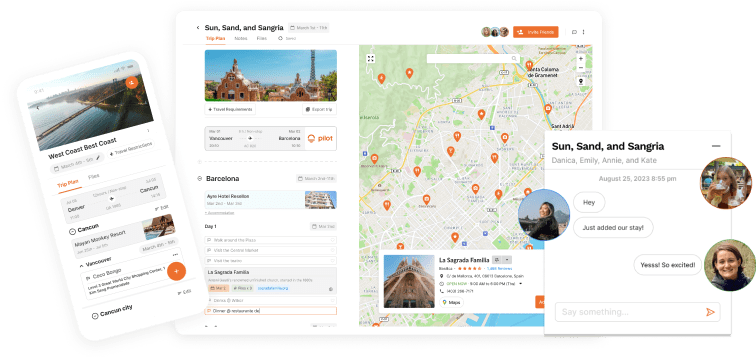Table of Contents
Calling all backpackers! Are you looking to up your game when planning your next backpacking trip? Whether you're brand new to backpacking or you're looking to find more efficient ways to plan a backpacking trip, I've laid out a list of helpful tips and tricks!
For those looking to go on an unforgettable journey, this guide outlines fool-proof steps to plan the ultimate backpacking trip! I'll prepare you for everything from booking transportation to packing meaningful items that fit within weight limits.
So get ready... it's time to start planning your dream backpacking trip!
Planing a Successful Backpacking Trip: 10 Simple Steps!
The planning process can seem daunting for those just starting their backpacking journey. But don't worry! Just follow these ten easy steps.
Step 1: Set a Budget
Before you leave, set a budget for your trip. This will help you stay on track and avoid overspending!
Start by calculating the cost of flights, accommodation, food, transportation, and any other expenses you may incur during your trip.
Once you know how much money you need to bring with you, create a budget plan that will help you stay on track.
Some handy travel apps like Tripcoin and Splitwise help travelers like you keep track of their spending.
A wise traveler knows that things hit the fan sometimes, so put aside money, depending on your destination, for emergency expenses. This extra money can cover lost or stolen items, medical bills, or even an unexpected flight change.

Step 2: Choose Your Destination
Before you plan, you need to decide where you want to go! It might seem obvious, but the world is vast, and you might find that the country you choose has more options than you considered.
For instance, do you want to plan a backpacking trip in Europe? Where exactly do you want to go, and does the destination fit your budget? A trip to Albania is much more budget-friendly than one to Iceland, and when you look closer at the country, you might find that one city is considerably cheaper.
Take the gorgeous country of Germany, for example. It hosts numerous world-class cities such as Berlin, Munich, and Hamburg. Did you know that Dusseldorf offers a more affordable experience than Berlin and has art, museums, and vibrant nightlife?
Once you have a list of potential destinations, it's time to start researching how to get there so you can start exploring.
Step 3: Book Transportation
Depending on your budget and the length of your trip, consider booking flights, buses, trains, and even boats.
You may be unable to book all transportation in advance. On a trip to Southeast Asia, for example, you will find that private bus companies and government buses only sometimes have online booking services and require in-person reservations. Despite it being 2023, some places still prefer old fashion methods.
Fear not! You'll likely be able to find a bus to your next destination. Be sure to ask your hostel owner for advice! In some cases, they can book for you for a small fee. If not, they are likely to be able to point you in the direction of the city bus station, where multiple buses are going to your destination.
For your backpacking trip across Southeast Asia, go to 12go.Asia to book your buses, boats, and even bus-boat combos. Be advised that this isn't the full schedule, and you'll likely have more in-person options.
Those backpacking out West in the United States should go to Amtrak or Greyhound to book their tickets. And those traveling across Europe, try Flixbus or BlaBlaCar, a carpooling and bus app.
Don't forget your flights! When you're on a budget, stick to cheap flights and budget airlines. Compare prices on Skyscanner to find the best deals.
As a traveler, you must be prepared to leave some things up to chance. Be ready for unexpected delays, cancellations, and last-minute changes in plans.
Step 4: Research Accommodation Options
Once your transportation is sorted, it's time to look for accommodation. Depending on the country you're visiting, various options such as hostels, hotels, Airbnb, Couchsurfing, and camping may be available.
Hostels are usually the most budget-friendly option for backpackers and often provide an excellent opportunity to meet other travelers.
Airbnb is also a great option for those who want more privacy and comfort. Whereas couchsurfing helps you save money while meeting locals and experiencing the culture of the place you're visiting.
But before you book, read reviews and check out the amenities. Some hostels offer free breakfast, Wi-Fi, and even laundry services.
Finally, camping can be a great way to explore nature while keeping your budget low. Be sure to research the local laws before pitching your tent.
Check out sites like Hostelword and Couchsurfing to learn more about your options and see what choices fit your budget.

Step 5: Pack Light
When it comes to backpacking, the less you bring, the better. You don't want to be weighed down with unnecessary items. Make sure to pack only the essentials and leave some room for souvenirs!
Start by listing all the items you will need for your trip. This should include clothing, toiletries, electronics, and other items you may need, including prescription medication.
Make copies of your passport, driver's license, and other important documents you may need while traveling. Store these copies in a safe place, such as a waterproof and sealed bag.
Be sure to check the weather of your destination and pack accordingly. If you are traveling to a cold climate, bring layers that can be easily removed or added depending on the temperature.
Stick to basic colors that pair well with multiple items, and bring one or two fancier pieces for an evening out. This allows you to get more out of the few things in your bag.
If you're looking for a more detailed list to reference, check out this comprehensive list specific to backpacking!
Step 6: Research Your Destination
Before you embark on your backpacking trip, it's essential to do some research about the places you are visiting. Read all travel advisories that may be in effect for your destination. This will help you stay safe while traveling and avoid potential dangers.
For my single female travelers, read what other female travelers are saying about a location by searching the country's name and then female travel on Facebook. You will likely find hundreds of posts and even groups where you can inquire about security.

Step 7: Get Vaccinated
We all live in a post-covid pandemic world, where the status of your last doctor's visit is more important than ever.
Some countries will require proof of vaccination or a negative covid test upon arrival or at some point during your stay. Be prepared to provide those documents.
You can learn about your destination country's requirements by going to the official government website or contacting your airline to understand which vaccines are required at the arrival gate.
Remember that adventurous backpackers going to unique destinations across Africa, South America, and Southeast Asia sometimes require particular vaccinations. For instance, the Yellow Fever vaccine is required in some African countries.
Check out your national health service's website, such as the CDC or NHS, to learn more about travel vaccinations.
Step 8: Plan Your Itinerary
Start by mapping out the cities or regions you want to visit. Be logical about it. For instance, don't plan to take a 10-hour bus to one city, stay for one night, and then take another 10-hour bus to the next place. You'll be exhausted and probably not have much fun.
Although we want to see and do everything in one trip, the fact is, we can't!
Be realistic about how many places you can see in the given amount of time, accounting for things like distance, transportation, costs, and your budget.
Be sure to consider other attractions besides the most popular tourist destinations. Don't rely solely on photos when planning your trip, as many of the places you see on Instagram aren't as nice in real life.
Reading reviews and researching locations with multiple attractions can be a great way to maximize your time, even if it means passing up on some well-known spots.
If you're feeling adventurous, consider planning a few days of spontaneous travel. This will allow you to explore and experience the unexpected.

Step 9: Find Out About Local Customs
Once you plan your destination and itinerary, it's time to research the local customs. This includes learning about the language, culture, and etiquette of the place you are visiting.
It is important to be respectful of the local customs and traditions. Researching ahead of time will help you avoid any potential cultural faux pas.
For example, if you are traveling to a country where it is customary to take off your shoes before entering a home, hostel, or even hotel, make sure you do so.
Step 10: Be Spontaneous!
Overpacking can be as detrimental as under-packing. Along the way, you may find yourself called to a different destination by an unexpected lover or friend you meet. You may fall in love with your hostel and want to extend your stay by one night or two, or you might find yourself in a place you never expected.
Plans are the roadmap, but you are the driver. Sometimes you have to veer off-road, make a U-turn, or head full-speed down the highway, screaming, "Get me out of here!"
So leave some room in your bag for spontaneity and unexpected adventures!
Start Planning Your Next Adventure Early!
The earlier you plan your backpacking trip, the better. This will give you more time to research and prepare for the journey. It would help if you started planning at least three months in advance. Six months is ideal.
Planning early will give you enough time to get your vaccinations, book flights and accommodation, and ensure that all your documents are in order. It also gives you plenty of time to research the places you want to visit and plan your itinerary.
Following these 10 easy steps will help you plan the ultimate backpacking trip. Bon voyage! We've only touched the surface of all the amazing things you can do on your next trip! Before you go, learn more about Pilot.










![Paris Neighborhoods Guide [2024]: Areas to Visit & Avoid!](https://assets-global.website-files.com/63d1baf79ce0eb802868785b/65b947376eff1a3e72606d03_Paris%20Neighborhoods%20Guide.jpg)

